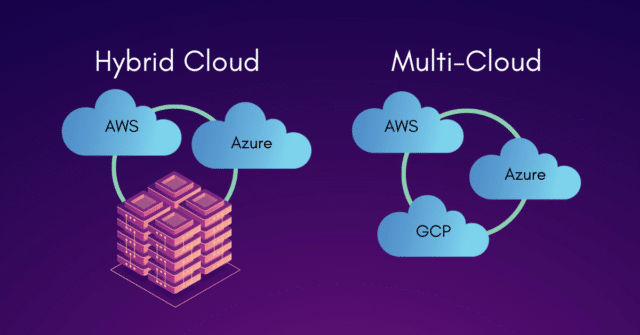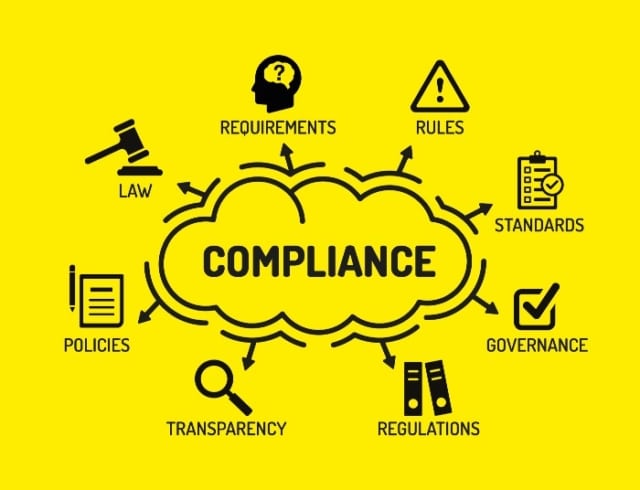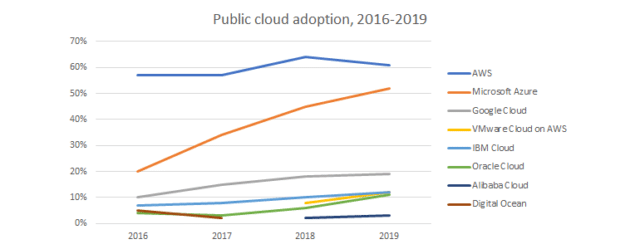Today, organisations are becoming borderless. The physical place where work is done is evolving. In fact, in many cases, individuals are working for organisations in multiple environments. Enterprises are looking to cloud adoption to provide optimal flexibility. The multicloud model can provide the flexibility organisations need.
What is Multicloud?
In a multicloud environment, an enterprise uses more than one cloud vendor to provide infrastructure. The multicloud approach distributes assets across several hosting environments from cloud providers.
Multicloud deployments can be any combination of cloud service providers. That means any combination of Software as a Service (SaaS), Platform as a Service (PaaS), or Infrastructure as a Service (IaaS). Typically, cloud deployments will be two or more public cloud vendors and refer to two or more private cloud vendors.
A multicloud environment aims to eliminate reliance on any one cloud provider. Enterprises opt for multicloud for many reasons, including vendor lock-in and compliance.
The difference between multicloud and hybrid cloud

Multicloud and hybrid cloud computing share many characteristics. However, they achieve different goals through separate IT infrastructure models.
A multicloud approach is an enterprise strategy. One in which businesses implement multiple cloud computing services to achieve specific goals. Multicloud deployment will involve cloud vendors of the same type, private or public, but with assets working together across the cloud environments. In these instances, enterprises use several cloud vendors to gain a variety of desired benefits.
A hybrid cloud is a combination of at least one private cloud and one public cloud. The two cloud services will operate independently but have the ability to orchestrate with one another.
Hybrid clouds provide benefits such as improved security and compliance. The interchange between the private and public clouds will be seamless. An enterprise will use implementation tools to deploy workloads and manage the balance between two cloud models.
Why move to multiple clouds?
Businesses can gain many benefits from multicloud infrastructure. Opting for a multiple cloud strategy comes at the price of greater complexity. More workload falls on the IT department.
More platforms and services mean IT personnel with knowledge of each environment. This can tie up the IT teams with managing multicloud, instead of pursuing more direct tasks. A digital transformation along the multicloud route can come at greater costs. This is due to the loss of bulk pricing of a single cloud provider.
So why do businesses embrace the difficulties of multicloud architecture? There are many benefits of using multiple cloud vendors, and sometimes multicloud is the only option an enterprise has to accomplish a specific goal.
Shadow IT
In large organisations, Shadow IT is inevitable. As enterprises expand, departments grow and multiply, and IT tech is deployed independently. This can happen as a quick fix to maintain service or to workaround shortcomings. This type of reactionary innovation puts an unplanned multicloud infrastructure in place.
Essentially, an organisation adopts a multicloud architecture by accident. But this accident provides business agility and a way of survival, and before long, the multicloud has become an ad hoc infrastructure for the enterprise.
Flexibility

Many enterprises plan to use multicloud services as a way to avoid vendor lock-in. In other words, businesses wish to avoid being tied to a single infrastructure. This allows businesses to react to the agile cloud computing industry. Organisations won’t be tied to technologies or services from only one cloud vendor.
With cloud computing evolving, maintaining flexibility is important. No one provider can do everything, or at least they can’t do everything equally well. When enterprises need to switch to new cloud-native technology, they can avoid paying substantial switching costs.
It doesn’t always involve outright switching. Having more options, lets organisations get the best of both (or multiple) worlds. For example, a business can decide to move workloads to the cloud provider that offers the best value. Or they may opt for the cloud vendor with the best performance.
Proximity
Having multiple cloud service providers solves another problem for enterprises; proximity to the end-user. By having multiple cloud providers, users connect to the data centre—or data centre—closest to them. This means latency, jitter, and packet loss are minimised. Organisations may find it optimal to run workloads on specific regions deployed by different cloud vendors.
Many data sovereignty laws require servers to be in geographic regions. Using multiple cloud providers can ensure compliance with these laws and make sure all boxes are being ticked.
Failover
Enterprises are susceptible to all of the inevitabilities of computing. Failure of cloud applications, servers, systems, hardware, and the network can all occur. Expect downtime at unexpected times.
When using multiple cloud vendors, businesses gain improved redundancy over a single vendor. And they gain a more reliable failover. Cloud-native services provide an available, scalable back up for data, workflows, and systems. An entire cloud service could go dark. But having another provider can ensure that mission-critical applications and services stay available.
This improved resiliency of failover also applies to other areas of cloud computing. Cloud storage, backup, and disaster recovery are more reliable with multiple data centres available in the nearest areas.
A service or vendor could suffer cyberattacks or become susceptible to malicious programs. Enterprises with multicloud can react quickly to keep systems online during service outages. Businesses gain the agility to react to IT disasters and cybercriminals. They can move more resources and workflow to unaffected cloud providers until a solution has been reached.
Compliance

Multicloud makes it easier to deal with data governance. Certain laws, regulations, and policies require data to reside in specific locations physically. This is especially important for organisations to spread across large geographical regions. Normally, this would require enterprises to create and maintain costly on-premises data centres.
But multicloud computing provides a solution to meeting compliance requirements. Enterprises can select from IaaS data centres depending on their regional public cloud providers. Not only will this ensure compliance, but better proximity increases performance for the end-user.
Benefits of RingCentral cloud solutions

Let’s face it. The future of business is changing. Cloud computing technology is rapidly evolving. Businesses need to be flexible and adapt to an ever-changing world. Digital nomads are becoming the norm. More and more people will be working from out of the office. RingCentral provides an all-in-one business communication solution.
With RingCentral, you and your team will be able to work together from anywhere. The UCaaS platform provides for all your communications. A digital transformation including messaging, video, and phone VoIP. And it’s so easy to implement because it is all put together in one straightforward app.
You and your team can be set up to go in no time. And adding new team members around the world takes only a matter of a few minutes. Connect with your teams from any device in any mode you need.
And don’t fuss around with security. Our UCaaS comes with enterprise-grade security. The cloud platform helps your business operate globally. But you can also expect industry-leading reliability with 99.999% uptime SLA.
A Gartner UCaaS Magic Quadrant leader for six years running, our unified approach brings your business the complete vision with excellent execution. Minimise external influence from affecting business continuity.
Learn more benefits of RingCentral Cloud Solutions.
What are examples of Multicloud?
Cloud computing is forever expanding. Multicloud providers can help you meet a limitless number of business goals.
One example would be an organisation using a multi-tenant public cloud such as Google Cloud Platform (GCP) to test applications. That’s a cloud platform with ease and speedy access to compute and store resources. But the same enterprise may deploy the application with a different cloud provider. One that offers better security and compliance, such as Red Hat.
Or an organisation may need to meet compliance requirements. They can use a cloud provider in a specific location. For instance, for customer relationship management (CRM), the business might choose RingCentral’s cloud-based CRM platform. Then, they could use G Suite for productivity tools, and Dropbox for cloud storage services.
The enterprise then chooses an IaaS like AWS or Microsoft Azure to host cloud infrastructure. Thus, providing computing resources that scale on demand.
How to manage and automate a multicloud environment
Multicloud can provide endless possibilities and unique solutions for enterprises. But with all of that flexibility come technical complexities and implementation issues. Initial business planning can make these issues easier to deal with.
Despite best-laid plans, though, changes are constantly required. As technology evolves, cloud management becomes more important to users of multicloud.
Multicloud management

Management of multicloud architecture involves monitoring. We mean maintaining tight control of infrastructure, platforms, and applications, alongside control of assets distributed across multiple cloud environments. Cloud management ensures the operational availability of those cloud computing resources. High-level monitoring and administration tools are available for IT personnel to use.
Today cloud management platforms (CMPs) provide aid for enterprises in managing multicloud infrastructure. CMP tools cover all cloud functionality. They manage multiple cloud providers in different functions. Assisting in areas such as provisioning, monitoring, analytics, cost, recovery, security, and compliance.
CMPs help organisations manage multicloud from a unified perspective,., but with a blend of cloud-agnostic and cloud-specific capabilities.
Many enterprises are already using automation technologies for different teams managing individual domains. However, there are many cloud-native technologies available, such as the Kubernetes platform. That is an open-source container-orchestration system capable of being deployed to multiple hosts for automation.
Automation of cloud management allows for workload scalability and proximity to the end-user. Enterprises can use tools to automate compliance. The platforms can also provide analytics on cloud automation, deployments valuable data that organisations can use to maximise the efficiency of the process.
What to manage?

Using multiple cloud vendors brings multiple pricing plans. Users have to tT, so users have to translate costs across platforms. Different vendors call similar services by different names. The IT team can decode invoices. They can discover which vendors charge the best price for the desired services.
Multicloud infrastructure does not mean that you have a separate infrastructure. Cloud platforms and cloud database centres must have interoperability. Of course, cloud technology will change, and the way they operate will shift along with that. The IT systems must be able to manage this relationship and adjust accordingly.
By introducing multicloud, enterprises increase the challenge of identity management. The IT department needs to manage who has access to which platform or service. But they will also need to maintain up-to-date security within these processes.
Cloud vendors update tools and applications as much as in any other computing sector. Organisations will need a way to keep abreast of these changes. The right people need to be up to date with the right information.
Top multicloud providers
According to the IBM Institute for Business Value, 98 per cent of companies are projected to use multiple hybrid clouds by 2021. These enterprises will want to be familiar with multicloud vendors. But they also need to understand multicloud management systems.

Most major cloud providers offer multicloud support. The top providers are Amazon Web Services (AWS), Microsoft Azure, and Google Platform Cloud (GCP). All three cloud providers can be paired or combined for a multicloud model.
Enterprises are trending towards multicloud with the major providers. According to the Kentik report, 58% of multicloud users use more than one of the three major cloud services providers.
As more businesses move to multicloud adoption, they should focus on which cloud solutions work for them. With the infrastructure in place, enterprises will need to look at multicloud management.
According to Gartner’s Magic Quadrant, the best Cloud Management Providers are:
Flexera (RightScale)
Recently, RightScale has been targeting large enterprises with multicloud requirements. Delivery is via a SaaS model. RightScale has a wide breadth of cloud management functionality, and it supports the broadest set of cloud providers.
Scale
Founded in 2011, Scalr has a strong range of integrations and is managed via a simple graphical user interface (GUI) or API. This is particularly well-suited to enterprises that require an on-premises solution with CMP functionality. It’s also able to maintain performance with more than 1000 concurrent users. The scale can provision and deploy custom environments. It also has the ability to do policy and enforcement at the design and operational phases, not just when resources are consumed.
Embotics
Based in Canada, Embotics covers most of the functional areas of multicloud management. Large on-premises, virtualised environments are the main focus. Embotics boasts rapid time to value that enables organisations to deploy the platform quickly. According to Gartner, Embotics is well-regarded for customer focus, service, and support.
Morpheus Data
Recently, Morpheus Data has initiated a “deploy where you want it” model. Clients can install in their own data centre. The platform can also be publicly hosted by a management service provider (MSP). Tools include monitoring, logging, backup, and cypher services, as well as third-party integration. It is infrastructure-agnostic. This allows clients to deploy across a range of public clouds, private, and bare metal servers.

Enterprises have a constantly evolving market of multicloud solutions from which to choose. Recently, standalone products for multicloud management have become available. IBM’s Multicloud Manager was one of the first. The IBM cloud service automates deployment, management, and governance from a single control point. Using that control point, users can infuse AI across the IT operation toolchains.
Other solutions aim to offer multicloud management as part of a bigger picture. ServiceNow is a platform for workflow management. But has the ability to integrate with multicloud infrastructure for full capability.
There are so many cloud management tools, platforms, and services available. Enterprises must first decide what they are trying to achieve. Next, they can scour the market for multicloud solutions. There is potential for unlimited abilities with multicloud. But there are infinite solutions to manage the multicloud model. It can seem a paradox of choice.
Explore RingCentral cloud communication solutions

Many enterprises are already operating multicloud architecture. Even more, are seeking to move forward with a multicloud strategy in 2021.
Right now, cloud solutions are becoming more important to maintain business continuity. The future is unpredictable. Multicloud infrastructure gives your business flexibility. Not to mention the agility and adaptability to handle whatever comes your way.
Working from home will continue to trend into the next year. Unified Communications as a Service (UCaaS) solutions with RingCentral can handle all your communication needs.
Avoid wasting time switching between programs and apps. All services will be under one umbrella. Our all-in-one solution keeps productivity high and costs low. Make one payment for all the services your business needs.
UCaaS is the future. And the future is now. RingCentral Office lets your team communicate from anywhere in the world. And with any device on any communication channel.
The way organisations operate and function will continue to evolve. Stay on top of your business with our unified communications solutions. Lower your business costs by moving all your services to one vendor. With RingCentral Office, you can integrate with your organisation’s other cloud platforms. Schedule meetings via Outlook and Google Calendar. Blend features of Office with Google and Microsoft’s software suites.
And don’t worry about equipment costs, because the platform is hosted in the cloud. You won’t need to upgrade old hardware or mobile devices. The cloud service is easy to set up and manage. RingCentral Office UCaaS offers industry-leading functionality and 99.999% SLA uptime.
Originally published Feb 03, 2021, updated Apr 10, 2021

